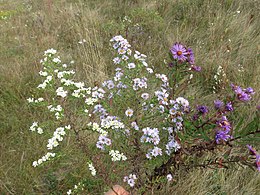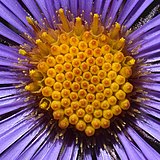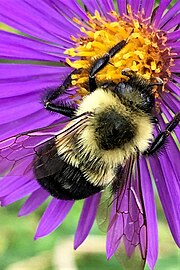New England Aster
- Aster novae-angliae L.
- Aster altissimus Moench
- Aster amplexicaulis Lam.
- Aster muehlenbergii Tausch
- Aster novae-angliae f. geneseensis House
- Aster novae-angliae var. monocephalus Farw.
- Aster novae-angliae f. rosarius House
- Aster novae-angliae f. roseus Britton
- Aster novae-angliae var. roseus A.Gray
- Aster novae-angliae f. spurius (Willd.) Voss
- Aster repertus Mottet
- Aster roseus Desf.
- Aster spurius Willd.
- Aster spurius var. novae-angliae (L.) W.P.C.Barton
- Diplactis novanglia Raf.
- Lasallea novae-angliae (L.) Semple & Brouillet
- Symphyotrichum novae-angliae f. roseum (Desf.) G.Wilh. & Rericha
- Virgulus novae-angliae (L.) Reveal & Keener
Symphyotrichum novae-angliae (formerly Aster novae-angliae) is a species of flowering plant in the aster family (Asteraceae) native to central and eastern North America. Commonly known as New England aster, hairy Michaelmas-daisy, or Michaelmas daisy, it is a perennial, herbaceous plant usually between 30 and 120 centimeters (1 and 4 feet) tall and 60 to 90 cm (2 to 3 ft) wide.
The usually deep purple flowers have up to 100 ray florets which are rarely pink or white. These surround the flower centers which are composed of just as many tiny yellow disk florets. The plant grows naturally in clumps, with several erect stems emerging from a single point. The stems are stout, hairy, and mostly unbranched. The untoothed, lance-shaped leaves clasp the stem with earlobe-like appendages, and the lower stem leaves often wither by the time of flowering.
New England aster generally grows in wet environments but also has been found in dry soil or sand. The seeds and nectar of this mostly conservationally secure species, which blooms August to November, are important to a wide variety of animals, including birds, bees, and butterflies. It has been introduced to Europe, Central Asia, Hispaniola, New Zealand, and some western states and provinces of North America.
The naturally-occurring hybrid species of New England aster and white heath aster (Symphyotrichum ericoides) is named Symphyotrichum × amethystinum and is commonly known as amethyst aster. It can grow where the two parents are in close proximity. There are roughly 50 cultivars of Symphyotrichum novae-angliae available, including the award-winners 'Brunswick', 'Helen Picton', and 'James Ritchie'. It has been used by indigenous Americans, such as the Cherokee, Iroquois, and Potawatomi, to heal multiple ailments.
Description
New England aster is a clump-forming perennial and herbaceous plant. Usually it is between 30 and 120 centimeters (1 and 4 feet) tall and 60 to 90 cm (2 to 3 ft) wide. Sometimes it can reach heights of 180 to 240 cm (6 to 8 ft). It is cespitose, growing in clumps with several erect stems emerging from a single point. The stems are stout and mostly unbranched. The upper stems and leaves, along with some parts of the flower heads, are covered with tiny glands on tiny stalks called "stipitate glands".
Roots, stems, and leaves
The roots either come from caudices or short rhizomes and are thick, appearing woody, sometimes with cormoid portions. There are usually from one to five strong, erect, hairy stems growing from the root base. These can be brown or purplish in color, and largely stipitate-glandular higher up.

Symphyotrichum novae-angliae has light to dark green, thin, and often stiff alternate and simple leaves. These occur at the base, on stems, and on the flower head branches which all have generally the same lanceolate appearance regardless of their location on the plant. The exception to this is the basal (ground level) leaves, which are usually spatulate or sometimes oblanceolate in shape. The lower stem leaves often wither or drop by the time the plant flowers.
The leaf margins are sometimes entire, meaning they are smooth on the edges with no teeth or lobes, or ciliate, meaning fringed with fine hairs on their edges. They are sessile, having no leafstalk, and they are auriculate, clasping the stem with earlobe-like appendages.
The leaves can vary in size, with the basal and distal (highest) leaves usually smaller than those occurring mid-stem. The basal leaves are sparsely hirsute and range 20–60 millimeters in length and 5–15 mm in length. Stem leaves are generally lanceolate or oblong with pointed tips and have stipitate glands on both sides. They average 50–100 mm in length by 5–20 millimeters wide. The distal leaves are oblanceolate, also stipitate-glandular, and softly-pubescent. Distal leaves range 30–80 mm in length by 6–15 mm wide.
Flowers

Symphyotrichum novae-angliae is a late-summer and fall blooming perennial with flower heads opening as early as August in some locations and as late as November in others. The inflorescences grow in paniculo-corymbiform arrays, also called "cymose corymbs". These inflorescences have many leaves and are quite crowded, typically with one head at the end of each small branch. Each open flower head can be up to 5 cm (50 mm) in diameter.
Involucres and phyllaries
On the outside the flower heads of all members of the family Asteraceae are small specialized leaves called "phyllaries", and together they form the involucre that protects the individual flowers in the head before they open. The involucres of S. novae-angliae are campanulate (bell-shaped) to hemispheric (half-spherical) and usually 7–9 mm, with low and high involucral measurements of 5 mm and 15 mm, respectively. The phyllaries are spreading and often reflexed and are covered with stipitate glands. They are in 3–5 (sometimes up to 6) somewhat equal rows.
Florets
Each flower head is made up of ray florets and disk florets in about a one to one ratio, with the former accepting pollen before, and longer than, the latter. The 40–100 ray florets grow in one, two, or multiple series and are usually deep purple, rarely pink or white. They average 10–20 mm in length and 0.8–1.3 mm wide. Ray florets in the Symphyotrichum genus are exclusively female, each having a pistil (with style, stigma, and ovary) but no stamen; thus, ray florets accept pollen and each can develop a seed, but they produce no pollen.
The disks have 50–110 florets that start out as yellow and later turn purple. Each disk floret has an average range of 4.5–5.5 mm in depth, with low and high measurements of 4 mm and 7 mm, respectively. The disk floret is made up of 5 fused petals, collectively called a "corolla", which opens into 5 lobes. Disk florets in the Symphyotrichum genus are androgynous, each with both male (stamen, anthers, and filaments) and female reproductive parts; thus, a disk floret produces pollen and can develop a seed.
Fruit

The fruits of Symphyotrichum novae-angliae are seeds, not true achenes but cypselae, resembling an achene but surrounded by a calyx sheath. This is true for all members of the Asteraceae family. After pollination, they become dull purple or brown with an oblong or obconic shape, are uncompressed, and are 1.8–3 mm long and 0.6–1 mm wide with 7–10 nerves. They also have tufts of hairs called "pappi" which are tawny or rose-tinged in color and 4.5–6 mm long.
Chromosomes
S. novae-angliae has a monoploid number (also called "base number") of five chromosomes (x = 5). The species is diploid with a total chromosome count of 10.
Taxonomy
History and classification
The species' basionym (original scientific name) is Aster novae-angliae L., and it has many taxonomic synonyms. Its name with author citations is Symphyotrichum novae-angliae (L.) G.L.Nesom. Swedish botanist Carl Linnaeus, in 1753, formally described what we know today as S. novae-angliae. It is a member of the genus Symphyotrichum classified in the subgenus Virgulus. It has been placed in section Grandiflori, sometimes segregated then within its own subsection Polyligulae. It also has been segregated within its own section Polyliguli. The cladogram shown follows the circumscription of section Polyliguli for the species.
-
Symphyotrichum subg. Chapmaniana (1 species)
subg. Astropolium (11 species)
subg. Virgulus sect. Ericoidei sect. Patentes subsect. Brachyphylli subsect. Patentes sect. Grandiflori subsect. Mexicanae subsect. Grandiflori sect. Polyliguli sect. Concolores subg. Ascendentes (2 species)
subg. Symphyotrichum (55 species)

Several varieties and forms have been described, differing in flower color, but these generally are not recognized and are considered taxonomic synonyms of the species. F1 hybridization with S. ericoides can occur where the ranges of these two species overlap. Named Symphyotrichum × amethystinum (amethyst aster), the hybrid is intermediate between the parent species in most respects. No other hybrids with S. novae-angliae have been reported.
Etymology
The word Symphyotrichum has as its root the Greek symph, which means "coming together", and trichum, which means "hair". The species name novae-angliae translates to "New England", and the vernacular name "Michaelmas daisy" derives from the various asters, including this species, that tend to flower around September 29, the Feast of St. Michael.
The species' former genus, Aster, comes from the Ancient Greek word ἀστήρ (astḗr), meaning "star", referring to the shape of the flower. The word "aster" was used to describe a star-like flower as early as 1542 in De historia stirpium commentarii insignes, a book by the German physician and botanist Leonhart Fuchs. An old common name for Astereae species using the suffix "-wort" is "starwort", also spelled "star-wort" or "star wort". An early use of this name can be found in the same work by Fuchs as Sternkraut, translated from German literally as "star herb" (Stern Kraut). The name "star-wort" was in use by Aiton in his 1789 Hortus Kewensis for Aster novae-angliae. He used the common names "New England cluster'd star-wort" and "New England panicl'd star-wort" in this work.









